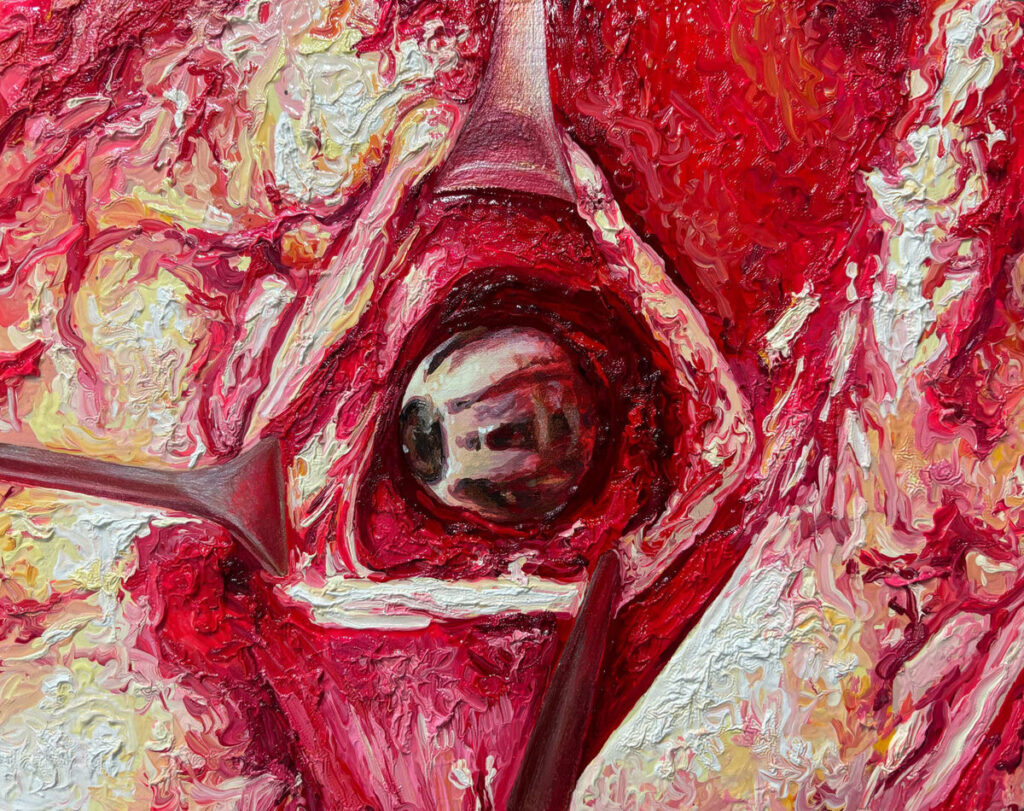The exhibition, titled A Porous Vessel, features pieces by seven artists who transform the idea and subject of the body using their own diverse mediums and forms. A Porous Vessel was curated by Ryan Van Der Hout, whose own exhibition stands adjacent to this group show. He said that the featured artists are friends or people he feels connected to because their artistic approach is similar to his.
The body acts as the main theme of this exhibition, even in pieces where it is not obvious that the artist is employing the body as their protagonist. For instance, in the three mixed medium pieces by Yi Hsuan Lai, there is nothing about the human body but instead the artwork creates its own body. The elements of the work that push out or sink in, the abstract and amebic forms, the tension between the brusque and the supple objects, build what I think is an abstract essence of the interior workings of the body.
Yi Hsuan Lai, Avoid and Expansion #2, 2024, Dye sub print on aluminum mounted on sintra inkjet print on nylon lycra, paint, screws, polyester fibre, 15 x 12 x 0.75 in (left) and Cave, 2024, Dye Sub print on Aluminum mounted on sintra, 21.6 x 16.5 x 1 in. (right)
In her ceramic works Sara Jimenez recreates Filipino funerary urns. She explores the idea of the spiritual body and casts herself among her ancestors and family. The idea of the transformation and movement of the body is extremely prevalent in these pieces. At a closer look viewers are able to appreciate the intricate work and details. The most interesting details are the openings in the urns which enhance the idea that the spirits are free to move in and around the space. Jimenez’s artworks contemplate the spaces of ritual and how the body (both physical and spiritual) explores these spaces.
Sara Jimenez, Why must our bodies end at the skin, 2023, ceramic, 8.5 x 6 x 11.5 in.
Some works in the show depict the body in a unique and intriguing way that catches the eye, like the intimate and gory experience of observing the work of Jordan Homstad, as well as the delicate and sharp pull that lives in Orchid Incision by Grace Wardlaw.
Jordan Homstad, (Foreign Body-01), 2024, oil, acrylic, mica powder on linen over wood cradle, 8 x 10 in.
Grace Wardlaw, Orchid Incision, 2024, glass, aluminum, steel medical tool, 10 x 6 x 4 in.
One will feel puzzled after viewing the prints by Aziz + Cucher. In the three Chimera prints it is notable that these pieces were made almost three decades ago and that they still feel open and hold conversations that are relevant today. Additionally, the use of the technology employed at that time to create them is staggering as the abstracted bodies look incredibly lifelike.
(L-R) Aziz + Cucher, Chimera #8, #1 and #3, each 1998, Light Jet c-print, 60 x 30 in.
In Jesse King’s photographs and in Leila Fatemi’s prints, fragments of the body are obscured in order to build a more powerful message. Jesse King employs this idea of composition in the form of a pink veil that wraps around the subject’s body in intimate, almost sensual, ways. The angles at which the photographs have been taken allow the viewer to get really close and personal with the artworks furthering the intimate energy that exists within the images. The veil clings to certain parts of the body and while covering those areas it also highlights them, drawing the viewer’s eye. An interesting conversation opens up with these ideas of sensuality, of what is and isn’t visible, especially with the adjoining fact that the model is a male figure that is posed and pictured in ways that are usually used to explore feminine beauty. The viewer is truly entranced by these photographs and the private aura as well as the illusion of movement given through the curves and creases of the veil, and with the play of light and colour.
Jesse King, Venus as a Boy 1 (left) and Venus as a Boy 2, each 2020, Chromogenic print, framed in walnut, 30 x 30 in
In contrast Leila Fatemi uses the concept of eliminating the original sensual energy of the nude women depicted in vintage images. The prints are titled Disorienting Orientalism, in reference to the artistic movement that was trending during the 18th and 19th century, when European male artists would represent images of the Eastern world, particularly the Middle East, that were highly fantasized. Oriental women were viewed as sexual objects, often posed in ways that highlighted certain parts of their bodies, reducing their humanity. Leila Fatemi places one Orientalist artwork on top of another and meticulously carves sacred geometry over them, covering specific parts of their bodies and creating a beautiful tension and movement between the artworks that cause us to land on neither.
Leila Fatemi, Untitled 2 from the series Disorienting Orientalism, 2024, hand cut inkjet prints, 10 x 10 in.
The conversation that flows between the artworks is captivating. The pieces are so distinct from one another but, still, they all allow the main idea to glide through them. Through a variety of mediums and forms, they still find a genuine common ground where one is really able to ponder and reflect on the idea of the body as a whole and its internal and external workings.
Sofia Diaz Aguilar
Images are courtesy of United Contemporary.
*Exhibition information: A Porous Vessel / Group Show: Aziz + Cucher, Jordan Homstad, Grace Wardlaw, Sara Jimenez, Yi Hsuan Lai, Leila Fatemi, Jesse King, November 14 – December 21, 2024, United Contemporary, 129 Tecumseth Street, Toronto. Gallery hours: Wed – Sat 11 am – 6 pm.







